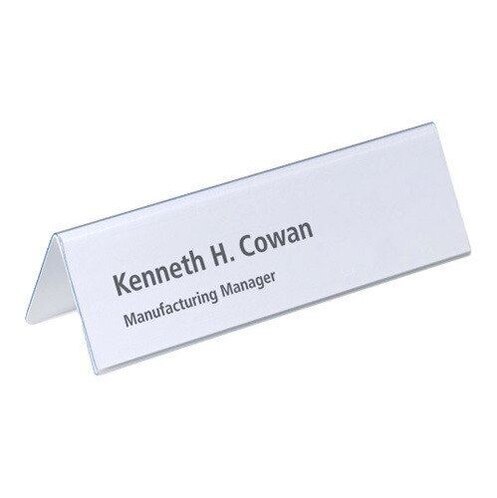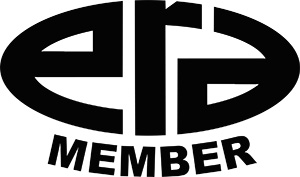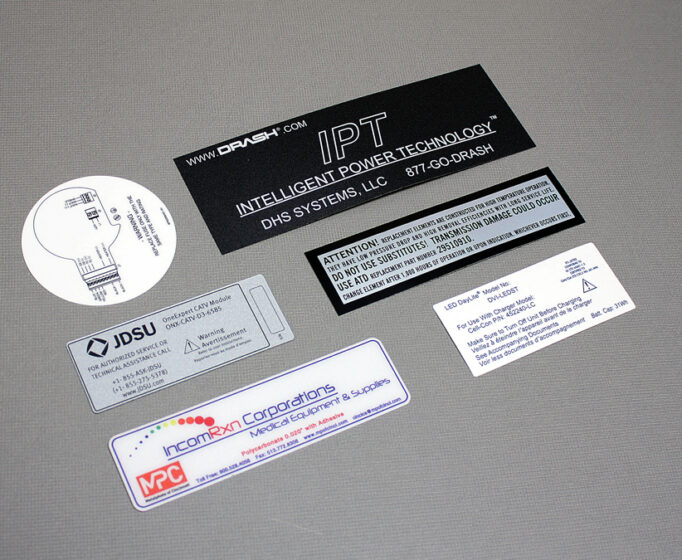How Plastic Nameplates Improve Operational Efficiency Across Industries
Recognizing Just How Plastic Nameplates Job: Insights Into Their Performance and Advantages
Plastic nameplates are vital devices for recognition and interaction in different settings. Constructed from long lasting products like acrylic and PVC, they offer both strength and aesthetic charm. Numerous printing techniques improve their presence and branding possible. Understanding their performance exposes not just their useful applications yet also the advantages they give companies. As sectors progress, the duty of plastic nameplates might shift, triggering a more detailed consider their recurring significance and development.
The Products Behind Plastic Nameplates
Plastic nameplates are crafted from a selection of products, each chosen for its distinct residential or commercial properties and suitability for different applications. Usual materials include acrylic, polycarbonate, and PVC, each offering distinct benefits. Polymer is favored for its quality and lightweight nature, making it excellent for indoor use and screen objectives. Polycarbonate, known for its high impact resistance, is frequently selected for environments where sturdiness is necessary (Plastic Nameplates). PVC, on the other hand, provides an economical service with decent weather resistance, ideal for outdoor applications.Additionally, the choice of material can influence variables such as shade retention, convenience of printing, and overall visual appeal. This choice process warranties that the end product fulfills specific needs, whether for branding, recognition, or ornamental purposes. Comprehending the residential properties of these products assists in making notified decisions when picking plastic nameplates for different requirements
Manufacturing Processes of Plastic Nameplates
The production procedures of plastic nameplates include several critical actions that assure top quality and longevity. Secret aspects consist of product choice methods, different printing techniques, and finishing and finish options. Comprehending these elements is essential for generating effective and aesthetically pleasing nameplates.
Material Selection Techniques
Selecting the ideal materials for producing plastic nameplates is essential for making certain toughness, aesthetic appeal, and functionality. Numerous plastic types are readily available, each offering special buildings fit for different applications. Polyvinyl chloride (PVC) is prominent for its affordability and resistance to ecological variables, making it excellent for outdoor usage. Acrylonitrile butadiene styrene (ABDOMINAL) offers enhanced impact resistance and is frequently selected for its remarkable strength and convenience. In addition, polycarbonate is favored for applications needing transparency and high impact resistance. The selection procedure includes thinking about elements such as the intended usage, ecological exposure, and preferred aesthetic qualities. Eventually, mindful product option significantly influences the efficiency and long life of plastic nameplates, satisfying diverse sector needs.
Printing Approaches Introduction
Product selection lays the groundwork for the subsequent printing techniques utilized in creating plastic nameplates. Various techniques, such as screen printing, digital printing, and pad printing, are employed to achieve premium designs and long lasting finishes. Display printing is favored for its capability to produce vibrant colors and is suitable for big runs. Digital printing, on the other hand, provides flexibility and accuracy, making it ideal for smaller sized orders with variable data or intricate layouts. Pad printing permits for the transfer of pictures onto uneven surfaces, suiting complicated shapes. Each printing approach adds distinctively to the end product's look and long life, making sure that the nameplates successfully communicate the desired message and stand up to environmental variables.
Finishing and Finishing Options
Finishing and coating alternatives play an important role in boosting the toughness and aesthetic allure of plastic nameplates. Various strategies, such as UV covering, offer a protective layer that stands up to scrapes and fading, considerably extending the item's life expectancy. Additionally, laminating options can supply a matte or glossy surface, enabling personalization to match branding needs. Electroplating and plating are additionally popular techniques, including a metallic shine while improving deterioration resistance. These finishings not just improve look but likewise add to the nameplate's functionality by guarding against environmental aspects. Additionally, specialized coatings, such as anti-graffiti coverings, assurance that nameplates maintain their readability and visual appeal in difficult problems. The appropriate finishing and covering choices can significantly improve the total worth of plastic nameplates.
Design Options for Customization
While discovering design options for customization, one uncovers a wide array of opportunities that can enhance the useful and visual charm of plastic nameplates. Shade choice is a main consideration, as vivid tones can attract interest while neutral shades promote professionalism and trust. Different font choices and sizes additionally personalize nameplates, guaranteeing readability and alignment with brand identity.Incorporating logos or images includes an unique touch, strengthening organizational branding. In addition, form modification enables distinct designs, varying from conventional rectangles to much more intricate kinds, catering to specific themes or environments.Textures such as matte or shiny surfaces can also affect the general appearance, giving a responsive measurement. In enhancement, the combination of attractive elements like borders or backgrounds enhances visual rate of interest. These modification options jointly enable companies to develop plastic nameplates that successfully connect their identity and message while fulfilling useful requirements.
,aspect=fit)
Sturdiness and Long Life of Plastic Nameplates
Although lots of elements influence the longevity of plastic nameplates, the option of product and production procedures plays a substantial function in their longevity. Top quality plastics, such as polycarbonate and acrylic, are typically chosen for their fundamental resistance to weather condition, uv, and effect radiation. These products can stand up to severe ecological conditions without significant deterioration, assuring that nameplates stay intact over time.Furthermore, advanced manufacturing techniques, such as injection molding and laser inscription, add to the right here robustness of plastic nameplates. These procedures develop specific and long lasting engravings that stand up to fading and wear. In addition, safety coatings might be related to boost resistance to chemicals and scrapes, additionally extending their lifespan.Ultimately, the combination of high quality products and effective manufacturing processes assures that plastic nameplates maintain their functionality and appearance for years, making them a trusted choice for various applications.
Applications Across Different Industries
Plastic nameplates serve a range of vital features across various industries. They are commonly used for commercial equipment identification, ensuring clear labeling for safety and operational effectiveness. Additionally, they provide effective workplace signs remedies and play a critical role in security and compliance markings, highlighting their versatility and significance in diverse environments.
Industrial Devices Identification
Reliable commercial tools identification is crucial throughout different industries, as it ensures security, effectiveness, and compliance with governing criteria. Plastic nameplates work as an essential tool in this process, supplying resilient and clear identification for equipment and devices. Industries such as construction, energy, and manufacturing utilize these nameplates to display critical details, consisting of operating guidelines, risk cautions, and maintenance schedules. Their strength to severe environments assurances that important information remains accessible, minimizing the threat of accidents and operational downtime. Additionally, adjustable attributes enable branding and details classifying needs, making plastic nameplates flexible throughout applications. On the whole, reliable equipment recognition via plastic nameplates promotes a safer office while enhancing efficiency in varied commercial settings.
Office Signage Solutions

In different markets, the importance of clear communication expands beyond industrial devices to workplace settings where signs plays an important function. Plastic nameplates work as efficient workplace signs solutions, giving crucial info such as employee names, task titles, and department designations. These nameplates improve professionalism and reliability and foster an inviting atmosphere, helping both personnel and visitors in navigating the work space. Additionally, they provide personalization options, permitting businesses to align signage with branding and aesthetic preferences. In settings like medical facilities, educational establishments, and corporate offices, resilient and clear signage warranties reliable communication and adds to business effectiveness. Ultimately, the use of plastic nameplates in workplace settings not just enhances quality yet also promotes a organized and natural office.
Safety And Security and Conformity Markings
While many businesses focus on visual appeals and branding in their signage, conformity and security markings are similarly necessary throughout various industries. These markings act as important tools for interaction, ensuring that customers and staff members know potential threats, security procedures, and regulatory needs. In production, as an example, plastic nameplates typically show advising tags and use directions to reduce risks. In health care, conformity signs informs workers concerning health practices and equipment usage, consequently advertising a secure environment. Furthermore, the toughness of plastic nameplates makes them suitable for various settings, withstanding damage from ecological factors. Generally, safety and security and compliance markings enhance operational efficiency, promote wellness, and warranty adherence to sector standards, making them important in contemporary work environments.
Benefits of Utilizing Plastic Nameplates
Many advantages make plastic nameplates an attractive option for services and organizations. One main benefit is their toughness; plastic nameplates are immune to fading, wetness, and different ecological aspects, making certain longevity in diverse setups. Furthermore, they are light-weight, making them easy to transfer and mount as needed.Cost-effectiveness is one more considerable advantage. Plastic nameplates generally need reduced manufacturing expenses compared to steel or wood choices, enabling organizations to maintain budgets while attaining specialist branding. Their flexibility also stands apart, as they can be customized in various shapes, dimensions, and colors to match branding requirements.Furthermore, plastic nameplates can be conveniently published with high-resolution styles, promoting clear visibility and reliable communication. Finally, they are frequently made from recyclable materials, lining up with environmentally aware methods. These mixed advantages boost the capability and appeal of plastic nameplates for a series of applications in various industries.

Tips for Selecting the Right Nameplate for Your Requirements
Selecting the right nameplate can significantly enhance a company's branding and interaction efforts. To make an informed decision, one must initially take into consideration the product. Plastic nameplates provide sturdiness and flexibility, making them optimal for numerous environments. Next off, review the design aspects, consisting of dimension, shade, and font style, ensuring they site here straighten with the organization's branding guidelines.Additionally, it is vital to assess the designated use the nameplate. For instance, if it requires to endure exterior problems, choosing UV-resistant alternatives is suggested. Personalization is another crucial factor; customized nameplates can show originality and professionalism.Lastly, budget factors to consider ought to not be forgotten. Contrasting prices throughout various distributors while factoring in top quality will assist in finding an appropriate solution. By taking these components right into account, organizations can choose a nameplate that effectively interacts their identification and function.
Regularly Asked Questions
Can Plastic Nameplates Be Recycled After Use?
Plastic nameplates can be recycled, depending on the kind of plastic used and local recycling centers. Correct disposal and reusing methods contribute to environmental sustainability, motivating the decrease of plastic waste in landfills.
How Do I Tidy and Keep My Plastic Nameplate?

Are Plastic Nameplates Waterproof or Water-Resistant?
Plastic nameplates usually display waterproof properties, safeguarding them from minor moisture direct exposure. Nonetheless, long term submersion or rough problems may jeopardize their stability. Plastic Nameplates. Users ought to take into consideration specific products and finishings for boosted water-proof abilities when picking nameplates
What Is the Typical Life Expectancy of a Plastic Nameplate?
The typical life expectancy of a plastic nameplate commonly varies from 5 to ten years, depending upon factors such as environmental exposure, worldly high quality, and upkeep. Normal care can prolong its functionality and appearance significantly.
Can I Order a Nameplate in a Certain Shape?
Customized shape options for nameplates are often readily available with numerous makers. Clients can request details layouts, making certain that the nameplate fulfills their visual and practical demands while preserving toughness and high quality throughout its lifespan. Product selection lays the groundwork for the subsequent printing methods made use of in generating plastic nameplates. Lots of variables influence the durability of plastic nameplates, the selection of material and manufacturing processes plays a significant role in their long life. These products can hold up against severe ecological problems without significant degradation, guaranteeing that nameplates remain undamaged over time.Furthermore, advanced manufacturing methods, such as shot molding and laser engraving, add to the toughness of plastic nameplates. Plastic nameplates can be recycled, depending on the kind of plastic used and regional reusing facilities. The ordinary life-span of a plastic nameplate generally varies from five to 10 years, depending on elements such as environmental direct exposure, material quality, and maintenance.